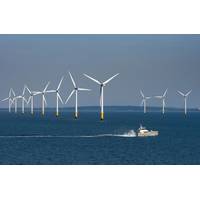Europe's Wind Capacity Growing Slower Than Projections
EU's installed wind capacity to reach 192 GW by 2020; Rise of 64 pct from 2013 levels but below rate expected.
Europe's installed wind capacity will increase at a slower rate to the end of the decade than previously estimated due to regulatory uncertainty and weak economic growth, an industry association said on Wednesday.
European Union countries will have a combined 192.4 gigawatts (GW) of installed wind energy capacity by 2020, 64 percent higher than 2013 levels, the European Wind Energy Association (EWEA) said in a report.
However, this is almost 40 GW below the EWEA's previous estimate five years ago of 230 GW by 2020, potentially a disappointment for wind turbine makers such as Vestas, Siemens (SIEMENS.NS) and Enercon.
"A cocktail of regulatory uncertainty, ongoing climate and energy discussions at EU level and rapidly evolving national frameworks has contributed to these new scenarios," said Justin Wilkes, deputy chief executive officer of the EWEA.
The European Commission has revised its estimate of final power demand in 2020 to 2,956 TerraWatt-hours (TWh), which is 11 percent lower than its 2009 estimate of 3,336 TWh.
This reduced estimate has had a impact on new power installations for all generation technologies, and has impacted investment plans, new orders and existing installations in markets across Europe, EWEA said.
Several European countries have slashed subsidies for renewables, including wind energy, because they were too much of a burden on their economies.
However, offshore wind markets such as Germany, France, Britain and Poland have quickly finalised policy reforms which should support a pick-up in wind installations, EWEA said.
Out of EWEA's new capacity estimate of 192 GW, 23.5 GW of installations will be in the offshore wind sector and there should be up to 124 billion euros ($167 billion) of investment in wind farms by 2020.
Wind energy should also produce 442 TWh of power, meeting nearly 15 percent of EU electricity consumption by 2020.
"While regulatory stability is still recovering in Europe, onshore markets such as Germany, France, United Kingdom and Poland will remain key for wind power installations," Wilkes said.
"For offshore (wind), extra confidence in the UK, continued deployment in Germany, and faster deployment in France and the Netherlands should continue to push the industry forward to 2020," he added.
By Nina Chestney











